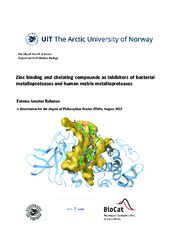| dc.contributor.advisor | Sylte, Ingebrigt | |
| dc.contributor.author | Rahman, Fatema Amatur | |
| dc.date.accessioned | 2023-09-28T11:30:46Z | |
| dc.date.available | 2023-09-28T11:30:46Z | |
| dc.date.issued | 2023-10-13 | |
| dc.description.abstract | Bacterial multi-drug resistance is a major health problem worldwide. Inhibition of bacterial virulence is suggested to be a promising strategy in the development of new antibacterial drugs. The present work has focused on identifying new inhibitors of the bacterial virulence factors thermolysin (TLN), pseudolysin (PLN, LasB) and aureolysin (ALN), which are all zinc metalloproteases (MPs) using enzyme kinetics studies and molecular modelling. A chemical group chelating the catalytic zinc ion of MPs, referred to as the zinc-binding group (ZBG) (e.g., phosphinate (PO2), carboxylate (COO-), thiolate (S-) and hydroxamic acid HONH-CO, sulfhydryl, etc.) is important for essential inhibition. The strategy in the present work was to use different compounds with a putative ZBG, including compounds with nitrogen as the zinc donor atom. The structure of the active site cleft of the virulence factors is very similar to that of the matrix metalloproteases (MMPs) and other human zinc MPs. Bacterial virulence inhibitors as drugs against bacterial infections should have limited effects on human endogenous zinc MPs. Therefore, we also tested their inhibition of human MMP-9 and MMP-14. Several compounds were found to inhibit the activity of the virulence factors, but most of the compounds also inhibited the human enzymes. However, the studies showed that the bisphosphonate-containing compound RC2 bound stronger to the bacterial virulence factors than to the human enzymes, while the catechol-containing compound BF471 was found to inhibit ALN. To our knowledge, this is the first reported small molecule inhibiting ALN. These compounds may be used as scaffolds to design new and potentially stronger inhibitors of bacterial virulence factors with therapeutic potential. | en_US |
| dc.description.doctoraltype | ph.d. | en_US |
| dc.description.popularabstract | The spread of antibiotic multi-resistance among human pathogenic bacteria is a major global health concern, and development of new treatment strategy are urgently needed. The enzymes thermolysin, pseudolysin and aureolysin are all bacterial virulence factors. The bacteria use theses virulence factors to invade the host and generate nutrition for bacterial growth. Molecules inhibiting the virulence enzymes are suggested to be promising alternative treatment strategies. The molecular structure of these virulence factors have huge similarities with important enzymes in the human body. Obtaining molecules that inhibit the bacterial but not the human enzymes is therefore challenging. Structural information about the inhibition of both the bacterial virulence factors and their human counterparts is therefore important. In the present thesis we have identified inhibitors of the three bacterial virulence factors using enzyme inhibition kinetics and molecular modelling. In addition, we have tested their inhibition of human enzymes with large structural resemblance with the three bacterial virulence factors. | en_US |
| dc.description.sponsorship | UiT, The Arctic University of Norway,
Helse Nord project number HNF1514-20
Biocat, Norwegian graduate School in Biocatalysis | en_US |
| dc.identifier.uri | https://hdl.handle.net/10037/31269 | |
| dc.language.iso | eng | en_US |
| dc.publisher | UiT The Arctic University of Norway | en_US |
| dc.publisher | UiT Norges arktiske universitet | en_US |
| dc.relation.haspart | <p>Paper I: Rahman, F., Nguyen, T.M., Adekoya, O.A., Campestre, C., Tortorella, P., Sylte I. & Winberg, J.O. (2021). Inhibition of bacterial and human zinc-metalloproteases by bisphosphonate- and catechol-containing compounds. <i>Journal of Enzyme Inhibition and Medicinal Chemistry, 36</i>(1), 819-830. Also available in Munin at <a href=https://hdl.handle.net/10037/21906>https://hdl.handle.net/10037/21906</a>..
<p>Paper II: Rahman, F., Wushur, I., Malla, N., Åstrand, O.A.H., Rongved, P., Winberg, J.O. & Sylte, I. (2022). Zinc-Chelating Compounds as Inhibitors of Human and Bacterial Zinc Metalloproteases. <i>Molecules, 27</i>, 56. Also available in Munin at <a href=https://hdl.handle.net/10037/23748>https://hdl.handle.net/10037/23748</a>.
<p>Paper III: Rahman, F., Wushur, I., Chaulagain, B., Nguyen, T.M., Adekoya, O.A., Malla, N., Winberg, J.O. & Sylte, I. Interactions of substrates and phosphinyl-containing inhibitors with human MMPs and bacterial virulence factors. (Manuscript). | en_US |
| dc.rights.accessRights | openAccess | en_US |
| dc.rights.holder | Copyright 2023 The Author(s) | |
| dc.subject.courseID | DOKTOR-003 | |
| dc.subject | VDP::Medical disciplines: 700::Basic medical, dental and veterinary science disciplines: 710 | en_US |
| dc.title | Zinc binding and chelating compounds as inhibitors of bacterial metalloproteases and human matrix metalloproteases | en_US |
| dc.type | Doctoral thesis | en_US |
| dc.type | Doktorgradsavhandling | en_US |


 English
English norsk
norsk
